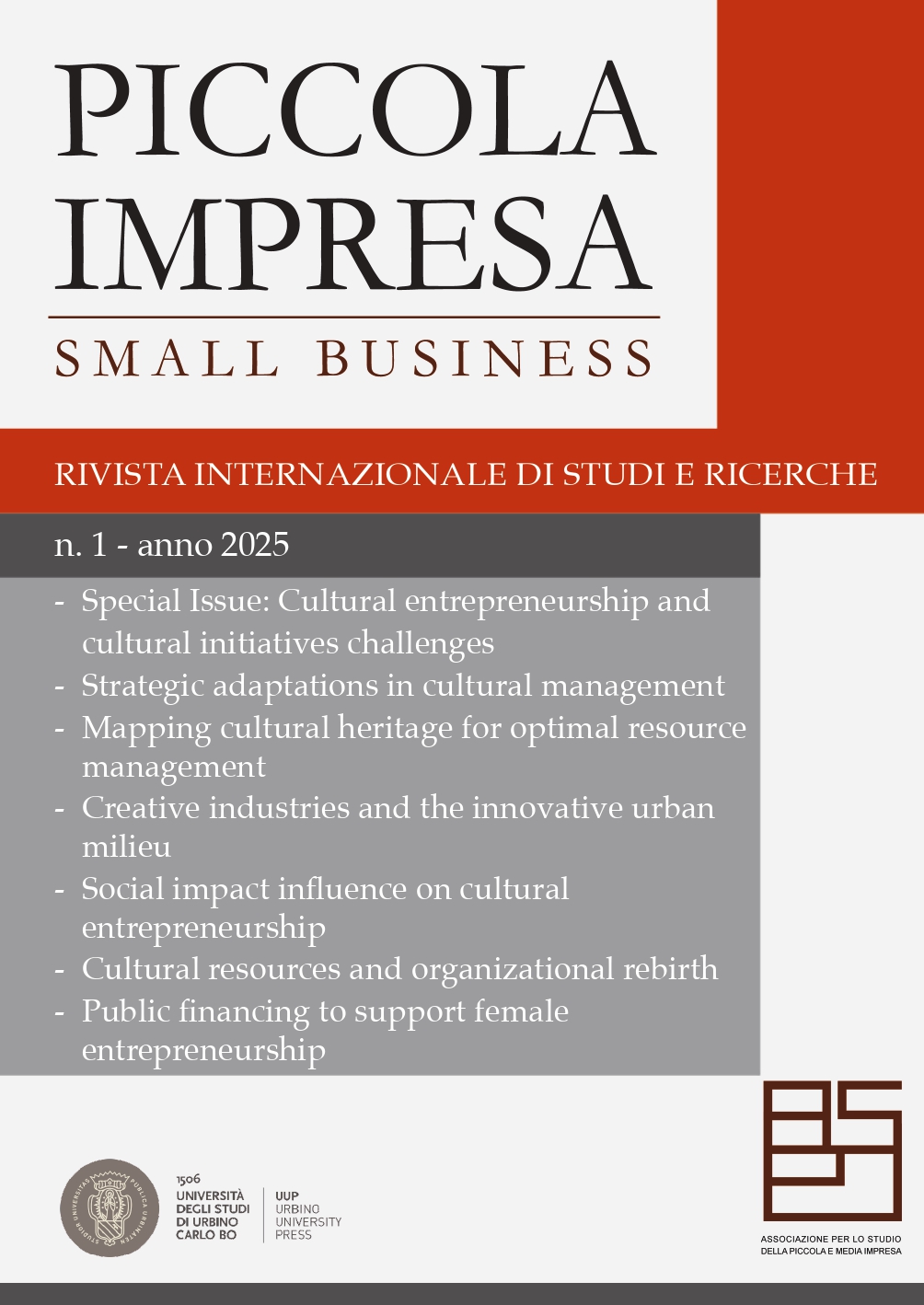Abstract
Purpose. This study explores the dynamic interplay between organisational resilience and innovation within Rome's cultural and creative industries (CCI) amid significant urban dynamics and cultural policy reforms. The research aims to understand deeper systemic challenges and transformations affecting CCIs and uncover strategies that enhance organisational resilience and foster innovation.
Design/methodology/approach. The study employs a mixed-methods approach to synthesise quantitative data from a specially designed questionnaire and derive qualitative insights from 33 semi-structured interviews with key stakeholders in Rome’s CCI. This methodological mix, supported by NVivo software for data integration and analysis, facilitates a holistic understanding of how cultural organisations navigate both longstanding and emergent challenges.
Findings. The findings reveal significant organisational agility across Rome’s CCIs, with entities exhibiting various degrees of innovation in response to shifting environmental pressures. Their strategic pivot towards more sustainable and resilient operational frameworks challenges traditional views on innovation that are linear and prescriptive.
Practical and Social Implications. The study underscores the importance of supportive infrastructure and financial mechanisms in the sustainability and growth of CCIs. Further, it explores how cultural organisations transform these challenges into opportunities for systemic growth and enhancing sectoral vitality, thereby emphasising a nuanced understanding of the complex interdependencies between cultural policy, organisational resilience, and innovation.
Originality of the study. This study highlights how adaptive resilience and targeted support can coalesce to foster vibrant and sustainable urban cultural ecosystems and provides a fresh perspective on managing cultural industries through a crisis, emphasising the role of innovation and strategic adaptation in sustaining cultural vitality.
References
Aureli, S., Del Baldo, M., Demartini, P., & Piber, M. (Eds.). (2023). Cultural heritage as a trigger for civic wealth creation and sustainable urban development. Rome: Roma TrE-Press. https://doi.org/10.13134/979-12-5977-201-5
Ben-Hafaïedh, C., Xheneti, M., Stenholm, P., Blackburn, R., Welter, F., & Urbano, D. (2024). The interplay of context and entrepreneurship: The new frontier for contextualisation research. Small Business Economics, 62(2), 571–582. https://doi.org/10.1007/s11187-023-00770-6
Bergamini, M., Van de Velde, W., Van Looy, B., & Visscher, K. (2018). Organizing artistic activities in a recurrent manner: (on the nature of) entrepreneurship in the performing arts. Creativity and Innovation Management, 27(3), 319–334. https://doi.org/10.1111/caim.12240
Borin, E., & Juno-Delgado, E. J. (2018). The value of cultural and regional identity: An exploratory study of the viewpoints of funders and cultural and creative entrepreneurs. European Journal of Cultural Management and Policy, 8(1), 16–29. https://doi.org/10.3389/ejcmp.2023.v8iss1-article-2
Council of the European Union. (2019). Council conclusions on the strengthening of European content in the digital economy. https://eur-lex.europa.eu/legal-content/EN/TXT/PDF/?uri=CELEX:52018XG1219(01)&from=EL
KEA European affairs. (2006). The Economy of Culture in Europe. https://keanet.eu/publications/the-economy-of-culture-in-europe/
European Commission. (2018). A new European agenda for culture. https://culture.ec.europa.eu/document/a-new-european-agenda-for-culture-swd2018-267-final
European Commission. (2020). Creative Europe: Supporting Europe’s Cultural and Creative Sectors: The Creative Europe programme. https://culture.ec.europa.eu/cultural-and-creative-sectors/cultural-and-creative-sectors
Florida, R. (2002). The rise of the creative class. Basic Books. https://doi.org/10.14712/12128112.3847
Healy, K. (2002). What’s new for culture in the new economy? The Journal of Arts Management, Law, and Society, 32(2), 86–103. https://doi.org/10.1080/10632920209596967
Howkins, J. (2002). The creative economy: How people make money from ideas. Penguin UK.
Li, F. (2020). The digital transformation of business models in the creative industries: A holistic framework and emerging trends. Technovation, 92–93, Article 102012. https://doi.org/10.1016/j.technovation.2017.12.004
Pagano, A., Petrucci, F., & Bocconcelli, R. (2021). Passion-driven entrepreneurship in small and medium-sized towns: Empirical evidence from Italy. Journal of Business & Industrial Marketing, 36(13), 210–219. https://doi.org/10.1108/JBIM-05-2019-0259
Peck, J. (2005). Struggling with the creative class. International Journal of Urban and Regional Research, 29(4), 740–770. https://doi.org/10.1111/j.1468-2427.2005.00620.x
United Nations Educational, Scientific and Cultural Organization. (2009). Framework for cultural statistics. UNESCO Institute for Statistics.
Vestrum, I. (2014). The embedding process of community ventures: Creating a music festival in a rural community. Entrepreneurship & Regional Development, 26(7–8), 619–644. https://doi.org/10.1080/08985626.2014.971076

This work is licensed under a Creative Commons Attribution 4.0 International License.
Copyright (c) 2025 Lavinia Pastore, Luigi Corvo

